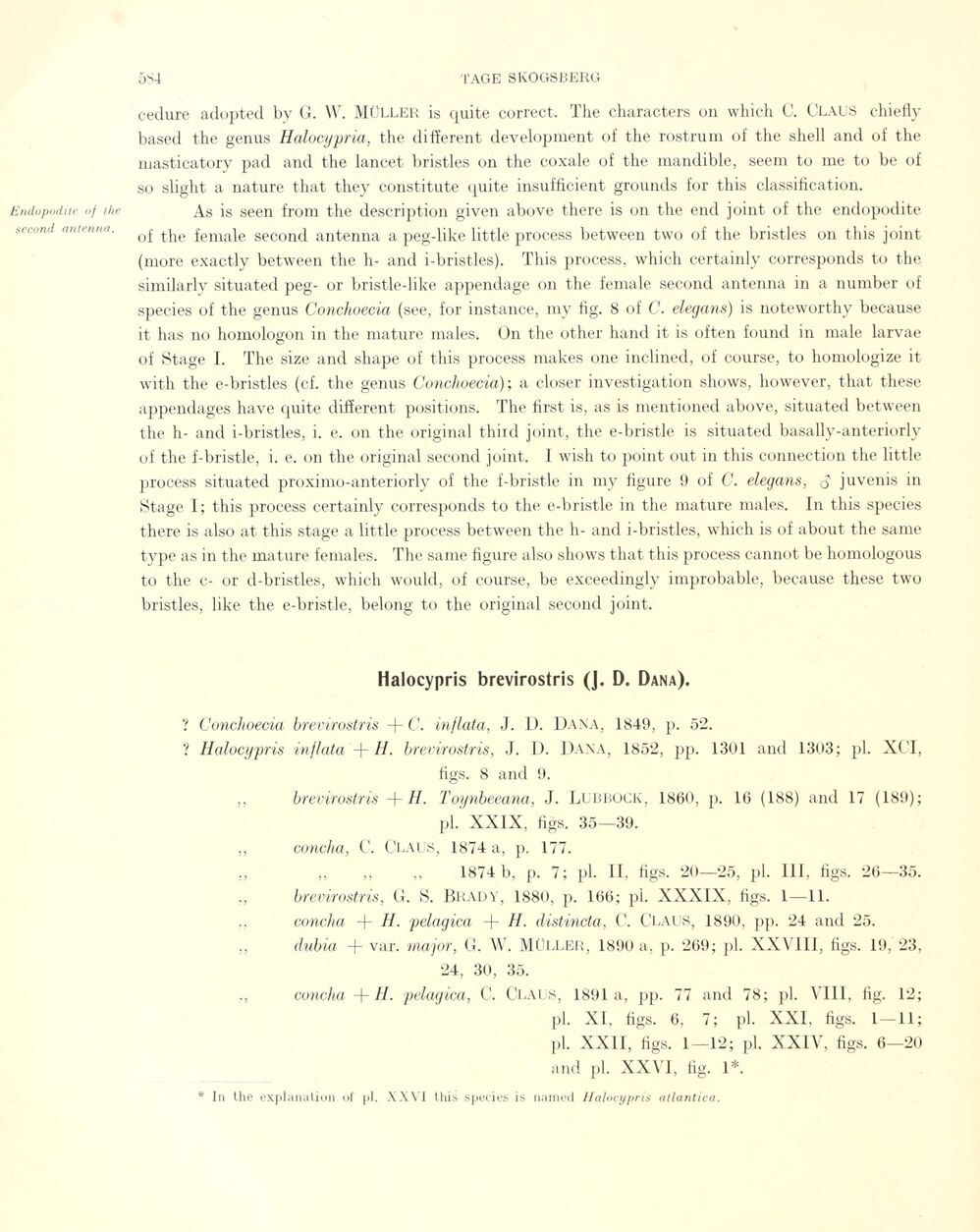
Full resolution (JPEG) - On this page / på denna sida - Sidor ...

<< prev. page << föreg. sida << >> nästa sida >> next page >>
Below is the raw OCR text
from the above scanned image.
Do you see an error? Proofread the page now!
Här nedan syns maskintolkade texten från faksimilbilden ovan.
Ser du något fel? Korrekturläs sidan nu!
This page has never been proofread. / Denna sida har aldrig korrekturlästs.
cedure adopted by G. W. MÜLLER is quite correct. ïlie characters on which C. Claus chiefly
based the genus Halocypria, the different development of the rostrum of the shell and of the
masticatory pad and the lancet bristles on the coxale of the mandible, seem to me to be of
so slight a nature that they constitute quite insufficient grounds for this classification.
As is seen from the description given above there is on the end joint of the endopodite
of the female second antenna a peg-like little process between two of the bristles on this joint
(more exactly between the h- and i-bristles). This process, which certainly corresponds to the
similarly situated peg- or bristle-like appendage on the female second antenna in a number of
species of the genus Conchoecia (see, for instance, my fig. 8 of C. elegans) is noteworthy because
it has no homologon in the mature males. On the other hand it is often found in male larvae
of Stage I. The size and shape of this process makes one inclined, of course, to homologize it
with the e-bristles (ef. the genus Conchoecia)-, a closer investigation shows, however, that these
appendages have quite different positions. The first is, as is mentioned above, situated between
the h- and i-bristles, i. e. on the original third joint, the e-bristle is situated basally-anteriorly
of the f-bristle, i. e. on the original second joint. I wish to point out in this connection the little
process situated proximo-anteriorly of the f-bristle in my figure 9 of C. elegans, o juvenis in
Stage I; this process certainly corresponds to the e-bristle in the mature males. In this species
there is also at this stage a little process between the h- and i-bristles, which is of about the same
type as in the mature females. The same figure also shows that this process cannot be homologous
to the c- or d-bristles, which would, of course, be exceedingly improbable, because these two
bristles, like the e-bristle, belong to the original second joint.
Halocypris brevirostris (J. D. Dana).
’! Conchoecia brevirostris -f- C. inflata, J. I). Dana, 1849, p. 52.
? Halocypris inflata + H. brevirostris, J. D. Dana, 1852, pp. 1301 and 1303; pl. XCI,
figs. 8 and 9.
,, brevirostris H. Toynbeeana, J. Lubbock, 1860, p. 16 (188) and 17 (189);
pl. XXIX, figs. 35—39.
,, concha, C. CLAUS, 1874 a, p. 177.
,, ,, ,, 1874 b, p. 7; pl. II, figs. 20—25, pl. III, figs. 26—35.
., brevirostris, G. S. BRADY, 1880, p. 166; pl. XXXIX, figs. 1—11.
concha -f- H. pelagica -f- H. distincta, Cl Claus, 1890, pp. 24 and 25.
., dubia + var. major, G. W. MÜLLER, 1890 a, p. 269; pl. XXVIII, figs. 19, 23,
24, 30, 35.
., concha + H. pelagica, C. Claus, 1891 a, pp. 77 and 78; pl. VIII, fig. 12;
pl. XI, figs. 6, 7; pl. XXI, figs. 1—11;
pl. XXII, figs. 1—12; pl. XXIV, figs. 6—20
and pl. XXVI, fig. 1*.
* In the explanatiori of pl. XXVI this species is named Halocypris atlantica.
<< prev. page << föreg. sida << >> nästa sida >> next page >>